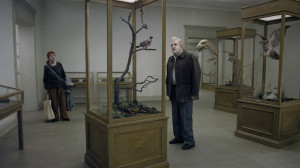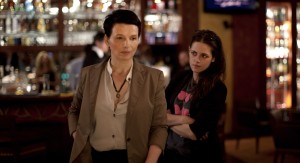The Toronto International Film Festival (TIFF), which wrapped up mid-September, is a peculiar beast. It’s one of the best showcases for foreign and art films, but it also hosts plenty of Hollywood movies with an eye on the Oscar race. A good chunk of North American journalists sent to the festival are there to cover the Oscar buzz. This year, the biggest Oscar hopefuls were the Alan Turing biopic “The Imitation Game,” starring Benedict Cumberbatch, the Stephen Hawking biopic “The Theory of Everthing” with Eddie Redmayne, and “Wild” with Reese Witherspoon, the story of a woman hiking the Pacific Crest trail as she recovers from grief. The most ambitious of us will try to cram upwards of seven films into a given day to make it possible to see smaller, foreign and indie fare. I averaged three per day. The headlines from the festival may focus on the celebrities, but the heart of the festival, and the reason we film critics love it so much, is its offerings of world cinema. Here’s a look at the top five off-the-beaten-path foreign films that most critics were buzzing about.

1. “A Pigeon Sat on a Branch Reflecting on Existence”
Although this Swedish black comedy had its World Premiere at the Venice Film Festival the week before, where it won the Golden Lion award for Best Picture, its first Toronto press screening played to a packed house. Directed by Roy Andersson, this is the final entry in his trilogy about the absurdity of human nature, and it’s as whacky and artsy as you’d expect from its title.
It begins with three hilarious vignettes about people dying, emphasizing the absurdity of it all, and it concludes with one of the most haunting images of the festival: A group of half-naked black people are herded into a giant oven, locked in, and set on fire by white men in old-fashioned military garb, while a group of rich white people in modern dress watch and sip champagne. Andersson reminds us that the cruelty of humanity, as well as the absurdity of everyday life, is a constant regardless of the current century.
The film is uneven, but many of the segments are brilliantly executed. I didn’t love it as much as some critics did, but it is one of the films that’s stuck with me most: I’m still thinking about it. In the Twitterverse, there have been many jokes made about the film. My personal favourite comes from David Ehrlich (@davidehrlich) of Little White Lies: “A Critic Sat At A Starbucks Reflecting On Subsistence: masterpiece.”

2. “Eden”
As soon as the new film, “Eden,” from critical darling Mia Hansen-Løve (“Goodbye First Love”), was slated for a World Premiere at TIFF, it went to the top of most of our to-see lists. The critical response, however, has been divisive. I found the film a major disappointment, clunky without purpose. I was far from alone, but there were just as many critics who found the few things that did work in the film to be enough. Inspired by the story of her brother, Sven, who was a DJ on the Paris garage music scene in the nineties, this two-hour film follows Paul (a terrific Fêlix De Givry), an aspiring DJ, over more than a decade as he fails to mature in any way from his 18-year-old self, including in his musical tastes. At 30, he’s still a coke addict, massively in debt, financially dependent on his mother and unable to engage in a mature relationship.
The party scenes, which celebrate the music of the era and the excitement of the club scene, grow repetitive: Just like the hero, not much changes over time. Perhaps most frustratingly, for a film about the music scene, we never get to see Paul thinking deeply about the music or putting together a set. We don’t feel his passion for it nor does he seem to be serious about anything else. The film is at its best in the scenes between Paul and his various lovers, all of whom will eventually grow up and out of him: Hansen-Løve has always excelled at showing the tenderness and intimacy of romantic relationships, and these scenes come to life with her deft touch. But it’s not enough to save this meandering, repetitive film, from being a trifle.

3. “Force Majeure”
Swedish director Ruben Östlund’s new film, “Force Majeure,” had its North American premiere at TIFF, after generating serious buzz and praise at the Cannes Festival last May, where it screened in the Un Certain Regard section. It has since been chosen, over Andersson’s film, as Sweden’s submission for the Best Foreign Film Oscar. This observant black comedy finds wicked humor in a tense family drama, especially in how outsiders get pulled into it. The workaholic Tomas (Johannes Kuhnke) and his wife Ebba (Lisa Loven Kongsli) are on a ski vacation in Switzerland with their two young children, when an avalanche happens. Instead of protecting his family, Tomas flees and is later unable to own up to it. And so the arguments begin. They can’t have an honest conversation alone, so Ebba keeps bringing it up when outsiders are present, putting them in the awkward and funny position of mediating. The comedy is all about the pacing and rhythms of the conversation. Before long, what seems like an innocent blunder out of fear seems like a symptom of a much deeper problem: Tomas isn’t quite who Ebba thought he was, and she’s not sure she likes what she sees. Although it drags at times, this is a thoroughly thought-provoking and entertaining film. On the whole, it lives up to the buzz.
4. “The Duke of Burgundy”
Peter Strickland’s richly atmospheric “The Duke of Burgundy” is set in a Gothic mansion in the countryside where there seem to be no men, the women speak English but with slightly foreign accents, and the only leisure activity is studying and discussing rare specimens of butterflies. The film is a pas-de-deux between two unnamed women: the proprietor of the house (Sidse Babett Knudsen of Danish TV’s “Borgen,” terrific) and her lover, played by Chiara D’Anna, who plays the ingénue, but whose sexual appetite leans toward the darker side of things.
What seems like a straightforward relationship between a dominating partner (Knudsen) and a dominated one (D’Anna) reveals itself to be more nuanced and tangled. The power and control is not as clearly held as it may seem to be, and Knudsen’s character has reasons to be uncomfortable and unhappy with the dynamic. But as soon as those power dynamics are revealed, there’s little to hold the film together. It wasn’t the mind-blowing experience I was expecting given all the buzz and unfettered praise the film had been provoking. Nevertheless, it’s an impressively sensual and tactile film, despite the lack of nudity – though there is a great deal of lingerie – enthralling until the end.

5. “Clouds of Sils Maria”
When Olivier Assayas’s film, “Clouds of Sils Maria,” premiered at Cannes in May, it generated a lot of buzz for the lead performances by Juliette Binoche and Kristen Stewart. Reactions to the film itself, both at Cannes and Toronto, were mixed, but we could all agree that the always excellent Binoche has never been better, and that Stewart has finally been given a role worthy of her significant talents. Like Cronenbeg’s “Maps to the Stars,” which also played TIFF and Cannes, it’s the story of the relationship between a demanding, middle-aged actress, Maria Enders (Binoche) – Binoche is less juvenile than Julianne Moore’s character was, but both performances are stellar – and her assistant (Kristen Stewart) as she attempts to take on a role of personal significance.
At the start of her career, Enders played the manipulative ingénue in a play about a young assistant’s relationship with her older boss. Twenty years later, she’s been asked to play the boss in a revival, and her fears about aging are clouding her judgment about the characters and the story. As she rehearses her lines with her real-life assistant, fact and fiction start to blur. The film is a heady exploration of how subjectively we view art, but it’s so on-the-nose about it all that it winds up preaching more than it does exploring. But it’s still worth seeing for the terrific performances, and a chance to see Stewart shine in a role so unlike anything else she’s ever played.
Contact Alexandra Heeney at aheeney “at” stanford.edu
